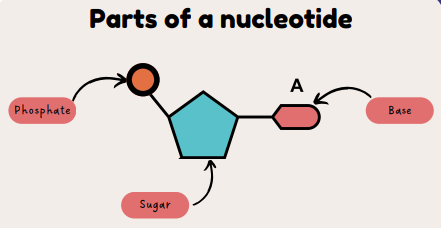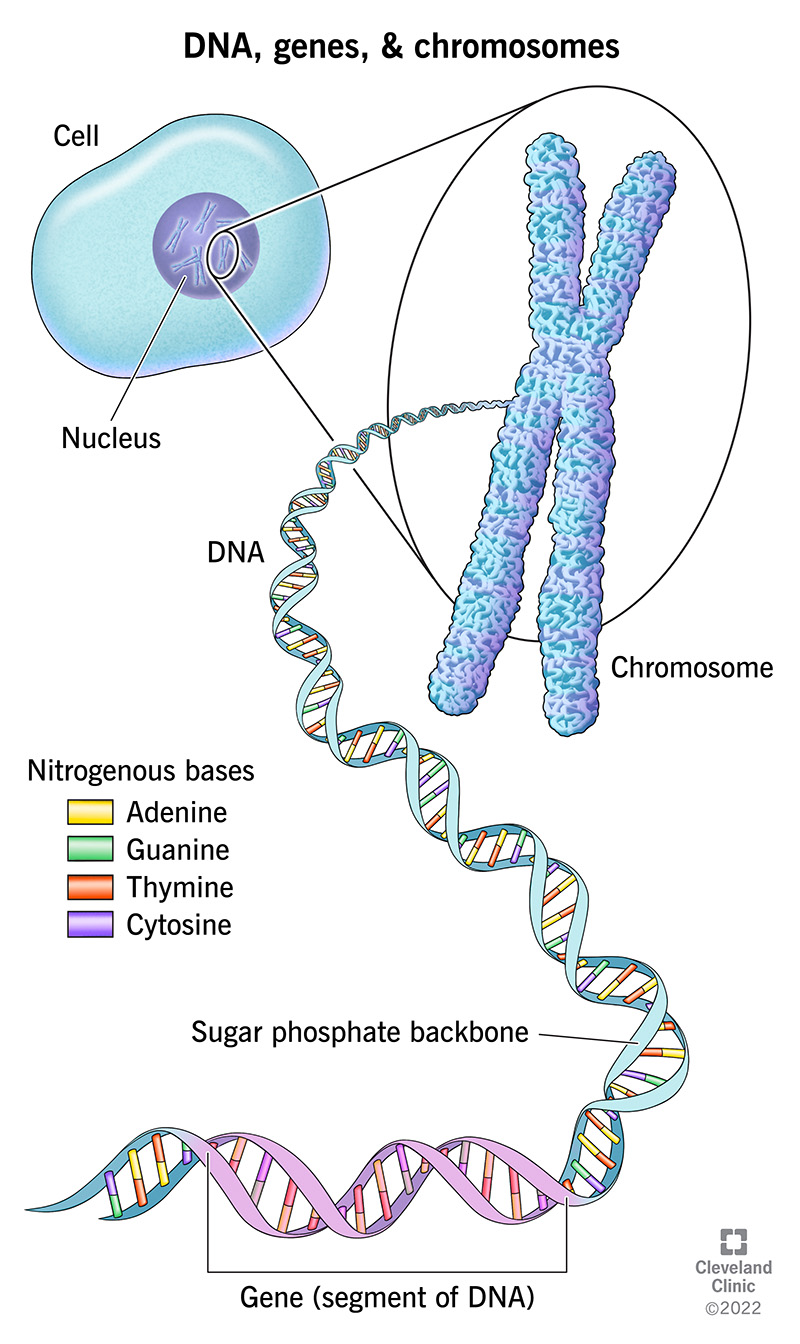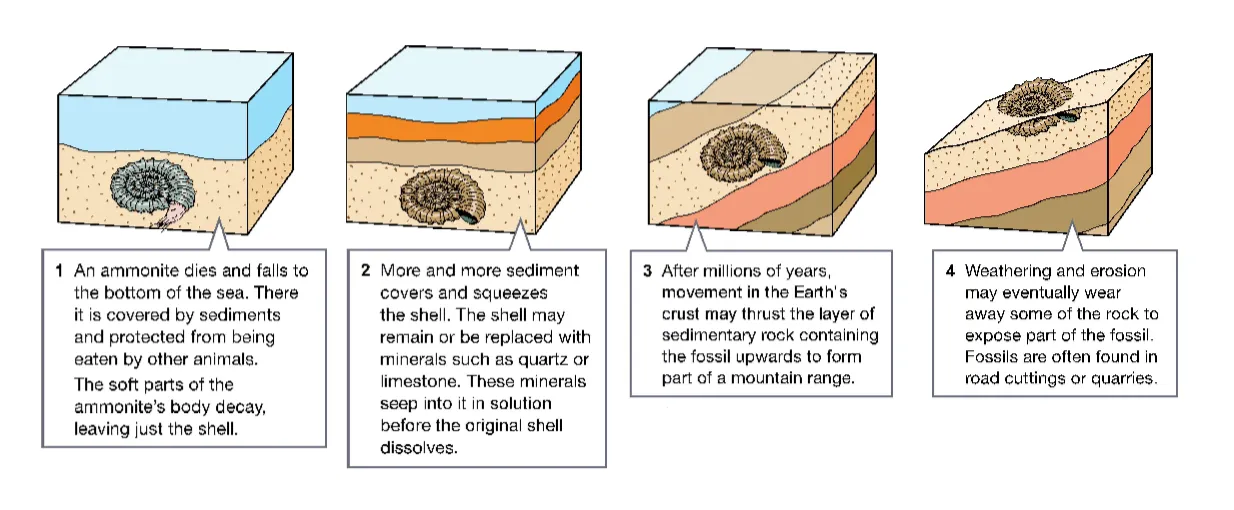Year 10 Biology
1/83
There's no tags or description
Looks like no tags are added yet.
Name | Mastery | Learn | Test | Matching | Spaced |
|---|
No study sessions yet.
84 Terms
What does DNA stand for?
Deoxyribonucleic acid.
What is DNA?
A molecule that carries genetic information in all living things
Determines the characteristics of living things
It is the molecule that carries genetic information for the development and functioning of an organism.
Who described DNA and when?
James Watson and Francis Crick in 1953
Describe the Watson-Crick model
The DNA molecule appears as a three dimensional double helix (twisted ladder).
What is the structure of DNA?
It has the same structure in all organisms
Made up of smaller molecules called nucleotides
(Building blocks of DNA)
The backbone of DNA is formed by alternating sugar and phosphates held together by a strong bond.
The rungs of the ladder are formed by the four nitrogen bases and are held together by weak hydrogen bonds.

Explain the nucleotide structure
Phosphate group
Deoxyribose sugar
Nitrogen rich bases (1 of 4)
Adenosine, Thymine
Guanine, Cytosine

What is the role of DNA
DNA stores genetic information, controls cell activities, and passes traits from one generation to the next.
What is a gene?
Segments of DNA that code for proteins or traits.
What are chromosomes?
They are thread-like structures, found within the nucleus of cells, that contain DNA, which carries genetic information
DNA vs Gene vs Chromosome structure

How are genes inherited?
Genes are passed from parents to offspring through chromosomes in sperm and egg cells.
What determines inherited traits?
Traits are determined by the combination of genes received from both parents.
What are dominant and recessive genes?
Dominant genes express their traits even if only one copy is inherited, while recessive genes require two copies to show.
What is the role of DNA in inheritance?
DNA carries genetic information that is copied and passed down during reproduction.
How do mutations affect inheritance?
Mutations are changes in genes that can create new traits or lead to genetic disorders.
What is genetic variation?
Genetic variation occurs due to differences in genes, leading to unique traits in individuals.
How do genes control inheritance?
Gene possesses a pair of alleles that helps in instructing the cells to express the traits by making proteins
What is DNA replication?
DNA replication is the process of making an exact copy of DNA before cell division.
What is the role of Helicase?
SCISSORS
Helicase unwinds and unzips the DNA double helix by breaking hydrogen bonds between base pairs.
What is the role of primase?
STARTER
Indicates the starting point for DNA Polymerase to add bases.
What does DNA Polymerase do?
BUILDER
DNA Polymerase adds new complementary nucleotides to the exposed DNA strands, forming two new strands.
What is the role of Ligase?
GLUE
Ligase seals gaps between newly synthesized DNA fragments (Okazaki fragments) on the lagging strand.
What are the 3 stages for DNA replication?
Unzipping the DNA stands (helicase)
Synthesizing new complementary stands (polymerase)
Sealing the strands into complete DNA molecules (ligase)

Why is DNA replication important?
It ensures genetic information is accurately copied and passed to new cells for growth and repair.
What is reproduction?
Reproduction is the biological process of producing new organisms.
Why is reproduction important?
It ensures the survival and continuation of a species.
How does reproduction contribute to genetic diversity?
Sexual reproduction mixes genes, creating variation for adaptation and evolution.
What are the two main types of reproduction?
Asexual (one parent, identical offspring) and sexual (two parents, genetically unique offspring).
How does reproduction help ecosystems?
It maintains population balance and supports food chains.
Asexual vs sexual reproduction
Feature | Sexual Reproduction | Asexual Reproduction |
|---|---|---|
Number of Parents | Two | One |
Genetic Variation | High (unique offspring) | Low (clones) |
Process | Involves fertilization (gamete fusion) | No fertilization, offspring from one parent |
Speed | Slower | Faster |
Examples | Humans, animals, most plants | Bacteria, fungi, starfish (fragmentation) |
What is Mitosis?
Mitosis is the process of cell division that produces two genetically identical daughter cells, used for growth, repair, and asexual reproduction.
What is Meiosis?
Meiosis is the process of cell division that produces four genetically diverse gametes, reducing the chromosome number by half, essential for sexual reproduction.
Difference Between Mitosis and Meiosis
Mitosis:
1 division
2 identical cells
same chromosome number.
Produces body cells
Meiosis:
2 divisions
4 diverse cells
half the chromosome number.
Produces gametes
Describe the process of mitosis
Interphase: Cell growth and DNA replication, preparing for cell division.
Prophase: Chromosomes condense, nuclear membrane breaks, spindle fibers form.
Metaphase: Chromosomes line up at the center.
Anaphase: Chromatids are pulled apart.
Telophase: Nuclear membranes form, chromosomes relax.
Cytokinesis: Cytoplasm divides, forming two cells.
PMATC - Please Meet At The Circus
Describe the process of meiosis?
Interphase: Cell growth and DNA replication, preparing for cell division.
Meiosis I:
Prophase I: Chromosomes condense, homologous chromosomes pair, crossing over happens.
Metaphase I: Homologous chromosomes line up at the center.
Anaphase I: Homologous chromosomes are pulled apart.
Telophase I & cytokinesis: Nuclear membranes form, and the cell divides.
Meiosis II: Similar to mitosis, but divides haploid cells into four non-identical haploid cells.
PMATPMAT
What is a chromatid?
A chromatid is one half of a duplicated chromosome, connected to its identical sister chromatid by a centromere.
Compare and contrast the two types of cell division.
Mitosis:
Purpose: Growth, repair, and asexual reproduction.
Number of divisions: One division (produces 2 identical daughter cells).
Chromosome number: Same as parent cell (diploid).
Occurs in: Somatic (body) cells.
Meiosis:
Purpose: Sexual reproduction (produces gametes: sperm and eggs).
Number of divisions: Two divisions (produces 4 non-identical daughter cells).
Chromosome number: Half of the parent cell (haploid).
Occurs in: Germ (reproductive) cells.
How is genetic information passed on to offspring from both parents by meiosis?
Meiosis reduces the chromosome number to make haploid gametes. In prophase I, crossing-over mixes genes, and independent assortment gives offspring a unique combination of genes from both parents.
What is haploid?
A cell with half the normal number of chromosomes, found in gametes (sperm and eggs).
What is a zygote?
A zygote is the fertilized egg cell formed when a sperm and egg combine, containing a full set of chromosomes (diploid).
Genetic Information in Fertilisation
Fertilization occurs when a sperm from the father and an egg from the mother combine to form a diploid zygote with genetic information from both parents.
What is a gamete?
A gamete is a reproductive cell (sperm or egg) that contains half the chromosome number of an organism.
Describe the role of gametes in sexual reproduction.
Gametes combine during sexual reproduction to form a zygote, providing half the genetic information from each parent to create a genetically unique offspring.
Explain how sex/gender is determined in humans
Sex is determined by X and Y chromosomes.
Females have XX chromosomes.
Males have XY chromosomes.
The father’s sperm decides the sex.
What are mutations?
Mutations are changes in the DNA sequence.
What causes mutations?
Errors in DNA replication or from the damaging effects of mutagens, such as chemicals and radiation.
How can DNA replication errors cause mutations?
Mistakes made during copying DNA can lead to changes in the sequence.
What is a fossil?
Fossils are the preserved evidence in rocks or soil of organisms that once existed on earth.
What are the different types of fossils?
Original
Replacement
Compression & Carbon film
Indirect or trace
What is an original fossil?
A fossil that contains the actual remains of an organism, such as bones, shells, or teeth, preserved without major changes.
Original fossils commonly include:
Marine organisms that had shells e.g., Molluscs
Vertebrates because they have teeth and skeletons
What is a replacement fossil?
A fossil where the original material is replaced by minerals, preserving its shape but not its composition.
Common in:
Petrified wood
Shells replaced by silica or pyrite
What is a Compression & Carbon Film fossil?
A fossil formed when an organism is compressed, leaving a thin carbon imprint.
Common in:
Leaves
Ferns
Soft-bodied organisms
What is an indirect (trace) fossil?
A fossil that records evidence of an organism's activity, not the organism itself.
Examples:
Footprints
Burrows
Coprolites (fossilized dung)
Describe the process of fossilisation?
An organism dies and is buried quickly by sediment, such as sand or mud
Over time, more layers of sediment build up and pressure increases, causing the organism’s remains to become compacted
Minerals gradually replace the remains, forming a rock-like fossil in the shape of the original organism

How does dry air help preserve fossils?
It removes moisture, slowing decomposition and preserving soft tissues and bones.
What makes permafrost an ideal fossil-preserving environment?
Its freezing temperatures prevent decomposition, preserving entire organisms.
Why do peat bogs preserve fossils so well?
Their acidic, low-oxygen conditions prevent decay, preserving soft tissues and bones.
How does amber preserve ancient organisms?
Tree resin traps small creatures, hardens into amber, and preserves fine details.
Why do tar pits help fossilize bones?
Sticky tar traps animals and prevents decay by protecting bones from scavengers.
Diploid vs Haploid
Diploid (2n): Two sets of chromosomes (e.g., humans have 46).
Each chromosome has two chromatids (sister chromatids) after DNA replication, before cell division.
Haploid (n): One set of chromosomes (e.g., humans have 23).
Each chromosome has one chromatid before DNA replication.
What are the general trends of the geological time scale?
As time has progressed:
The number of organisms (number of species) has increased
The complexity/specialization of organisms has increased from simple → complex
Life started as uni-cellular and has evolved to include multi-celluar organisms
Life began in aquatic environments and has evolved to exist in land
What is the fossil record?
A record that includes all the species of living organisms that have been found as fossils as well as their location and relative age.
Time line of earth, tracking its development since formation 4.5 billion years ago
Why are there gaps in the fossil record?
Decay & Erosion – Most organisms decompose or fossils get destroyed.
Lack of Hard Parts – Soft-bodied organisms rarely fossilize.
Limited Sedimentation – Some environments don’t support fossilization.
Tectonic Activity – Shifting plates can crush or bury fossils.
Incomplete Discoveries – Many fossils remain undiscovered.
What is relative dating?
A method in which the age of one fossil / rock is compared with the age of another fossil /rock to determine which is older. It relies on two basic factors:
Sedimentary rocks form in layers
Fossils are the same age as the rocks in which they are found
What is absolute dating? Provide an example.
Dating methods that give the actual age of rocks and fossils.
E.g. Radioactive dating
What is radioactive dating?
A method that uses the natural rate of decay (breakdown) of radioactive isotopes
Isotopes: atoms of an element that have different numbers of neutrons and therefore different atomic masses
Radioactive isotopes decay at a known rate and release particles that form radiation. These particles can be detected and measured.
What is half life?
The amount of time it takes for half of the radioactive isotope to decay.
What is carbon dating?
Carbon exists 3 isotopes:
Carbon-12
Carbon-13
Carbon-14
Half life is approx 5730 years
Carbon is absorbed by all living organisms through the foods they eat and through the atmosphere, but absorption stops when the organism dies. The rate of decay of carbon-14 however continues.
By measuring the amount of carbon-14 left in bones, an absolute age of the bone/s can be determined.
Advantages/disadvantages for absolute dating?
Advantages:
Provides specific numerical age.
Can date rocks and fossils directly.
Disadvantages:
Requires specific conditions for accuracy.
Can be affected by contamination or decay rates.
Advantages/disadvantages for relative dating?
Advantages:
Simple and cost-effective.
Works well for fossils in layered rock formations.
Disadvantages:
Does not provide exact age, only relative sequence.
Limited by available rock layers for comparison.
4o mini
What is the order of evolution on the geological timeline?
Cyanobacteria
Marine Invertebrates
Ray-finned Fishes
Lobe-finned Fishes
Amphibians
Reptiles
Birds
Mammals
When was the theory of natural selection made and by who?
Charles Darwin, 1958
What is natural selection?
Natural selection is the process where organisms with traits better suited to their environment are more likely to survive and reproduce, passing on those traits to future generations.
How do peppered moths show natural selection?
In England, before the Industrial Revolution, most moths were light-colored, blending with light-colored trees. After industrial pollution darkened the trees, dark-colored moths became better camouflaged and were more likely to survive and reproduce.
How humans can influence the evolution of different organisms overtime (artificial selection)?
Humans influence evolution through artificial selection by choosing organisms with desired traits to breed, like in agriculture (e.g., crops) or breeding animals (e.g., dogs). This accelerates the development of specific traits over generations.
Describe the selective breeding methods
Cross-breeding
The process of combining in the the offspring, a desirable feature of one individual, with a different desirable feature from another individual,.
Inbreeding
The process that allows related individuals to mate (breed).
This method is not often used in animal breeding as there are often health issues with offspring such as deformities, sterility and genetic disease.
In plant breeding, there are not as many problems with inbreeding and many plants self pollinate or cross pollinate.
What is sexual selection, and give two examples in the animal kingdom?
Sexual selection is when certain traits increase an individual's chances of attracting a mate.
Examples:
Peacocks with larger, colorful tails.
Deer with larger antlers.
What are the different types of evolution?
Fossils – there is increasing complexity in species, changes over geological time in a lineage and transitional forms
Comparative anatomy – homologous structures can be identified at many different levels of classification, such as the limb bones in classes of vertebrates
DNA – species that have similar anatomy have been shown to have many common genes
Protein Structure – closely related species have more similarities in amino acid sequences in particular proteins
Distribution of species – isolated islands have unusually high proportions of unique species; continents now separated by oceans and containing identical fossil species were once connected in the past
Embryology – embryos with similar anatomy share some of the same genes for development of the embryo. These same genes can exert different effects in different species
Homologous structures vs Analogous structures
Homologous structures:
Similar structure
Differing function
From a common ancestor
Analogous structures
Differing structure
Similar function
Not from a common ancestor
Compare divergent and convergent evolutionary processes
Divergent evolution: Species with a common ancestor evolve different traits (e.g., different beak shapes in birds).
Convergent evolution: Unrelated species evolve similar traits due to similar environmental pressures (e.g., wings in birds and bats).
What is a genome?
The complete set of DNA including all the genes of a cell, individual or species.
What is plasmid?
Ring of DNA found in bacteria.
What is DNA profiling?
Patterns of DNA fragments that are unique to each individual
What is gene splicing?
The process of adding a gene into or removing a gene from DNA